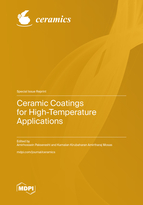Ceramic Coatings for High-Temperature Applications
A special issue of Ceramics (ISSN 2571-6131).
Deadline for manuscript submissions: closed (30 April 2023) | Viewed by 30025
Special Issue Editors
Interests: thermal barrier coatings; hot corrosion; splat morphology; ceramic and metallic composite; high entropy alloys
Interests: thin films; coatings; ceramics; thermal barrier coatings; coatings on bioimplants; corrosion; diffusion barrier coatings; geopolymer coatings; PVD coatings; PECVD
Special Issues, Collections and Topics in MDPI journals
Special Issue Information
Dear Colleagues,
High-temperature ceramic coatings, as we know, are gaining popularity in industries such as the aeronautics, chemical and petrochemical, fossil or renewable energy generation, and automotive industries because they provide an ideal option for providing thermal insulation and preventing deterioration and corrosion in harsh conditions.
Ceramic coatings are frequently used on metallic components to offer thermal shock protection, surface seals, erosion protection, diffusion barriers, sealants, and thermal insulation. Understanding the microstructure and behavior of ceramic coatings is critical for optimizing their functioning. Durability, ease of application, repairability, reliability, and long-term performance are all critical characteristics of such coatings. As such, this Special Issue will feature research and review articles on ceramic (for example, ZrO2, Al2O3, SiC, SiO2, HfC, TaC, and ZrC) and composite coatings used in high-temperature environments, as well as the factors influencing their selection and processing. Along with ceramic coatings, cermet-based coatings for use in high-temperature situations are also welcome.
This is a great opportunity for the high-temperature-coatings research community since it could lead to several applications in which ceramic coatings can improve the efficiency and longevity of coated metallic components.
Dr. Amirhossein Pakseresht
Dr. A. M. Kamalan Kirubaharan
Guest Editors
Manuscript Submission Information
Manuscripts should be submitted online at www.mdpi.com by registering and logging in to this website. Once you are registered, click here to go to the submission form. Manuscripts can be submitted until the deadline. All submissions that pass pre-check are peer-reviewed. Accepted papers will be published continuously in the journal (as soon as accepted) and will be listed together on the special issue website. Research articles, review articles as well as short communications are invited. For planned papers, a title and short abstract (about 100 words) can be sent to the Editorial Office for announcement on this website.
Submitted manuscripts should not have been published previously, nor be under consideration for publication elsewhere (except conference proceedings papers). All manuscripts are thoroughly refereed through a single-blind peer-review process. A guide for authors and other relevant information for submission of manuscripts is available on the Instructions for Authors page. Ceramics is an international peer-reviewed open access quarterly journal published by MDPI.
Please visit the Instructions for Authors page before submitting a manuscript. The Article Processing Charge (APC) for publication in this open access journal is 1600 CHF (Swiss Francs). Submitted papers should be well formatted and use good English. Authors may use MDPI's English editing service prior to publication or during author revisions.
Keywords
- thermal barrier coatings
- ultra-high-temperature ceramic coatings
- hot corrosion
- plasma spraying
- oxidation
- erosion
- wear
- thermal protection
- thermal spray coatings







